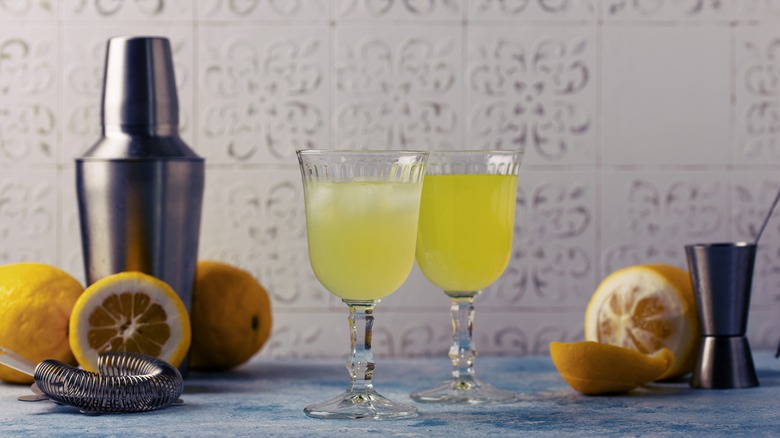How To Ensure The Absolute Best Ratio For Homemade Limoncello
A sip of limoncello can whisk you away to the Amalfi Coast — mentally, at least. This classic Italian lemon liqueur is a pleasantly sweetened take on lemons' bright tartness, perfect for everything from savoring a straight pour after dinner to mixing into spritzes to upgrading lemon bars. While there are plenty of great limoncello brands to try, making your own limoncello is a total game-changer. It's significantly cheaper, a fun and simple DIY project, and something homemade like this is a stellar gift.
Limoncello only requires lemons, vodka or grain alcohol, and water and sugar to make simple syrup. With such a basic ingredient list, it's clear the lemons really take center stage, so the ratio of lemons to alcohol you use can really make or break your finished result. You don't want more vodka flavor than lemon, but you also don't want something overpowering. To ensure the absolute best ratio, it's crucial to weigh all of your lemon peels before adding them to the liquor. A recipe for classic limoncello will tell you a number of lemons to use, but what you really need is a certain volume of peels, and that will vary with lemon variety and size. Consider this: While recipes vary, they tend to call for between eight and 12 lemons per bottle of vodka (750 milliliters). But importantly, you should aim for 200 grams of lemon peels. The difference between eight and 12 lemons to get 200 grams of peels, then, hinges on the lemons' sizes.
Choosing, measuring, and using your lemons
Authentic limoncello with a protected geographical indication is made in Sorrento, and it is the specific lemons from the Campania region that make this liqueur what it is. If you don't happen to be lemon-picking in the south of Italy, just choose lemons known to be sweeter and less acidic. Go for organic, because with a spirit featuring exclusively peels, you don't want peels that have been exposed to pesticides. Specific varieties available in the United States good for limoncello include Meyer lemons as well as Eureka and Lisbon lemons, whose differences you can spot by Eureka's textured peel and Lisbon's smoother one.
Whichever lemons you choose, it's a good idea to buy at least a couple extra beyond what the recipe you're using says. That way, when you weigh your peels later at home, you'll have extra lemons if the peels don't quite get near 200 grams. When you're peeling, make sure you don't get any of that white pith, as it's quite bitter. Once you have your pith-free strips, put them in a jug and fill it with the alcohol. Cover the jug and let it sit in a cool, dark place for up to a month. Then, make simple syrup and strain the vodka that's been sitting with the peels into the syrup's pot. Give it a stir, then it's ready to bottle, with the absolute best lemon ratio.

